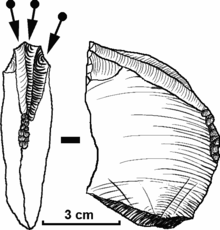Gargas Cave
The Caves of Gargas is located 700 meters southeast of Aventignan in the Hautes-Pyrénées in the region Occitania in France and belongs to the vicinity of the Franco-Cantabrian cave art . It consists of two halls and is classified as a historical monument . It has been the subject of scientific research since the beginning of the 20th century; initially by Émile Cartailhac and Abbé Henri Breuil .
The cave paintings in the Grotte de Gargas consist of red and black, sometimes ocher-colored (one even white) painted hands, very many (144 of 154 clearly recognizable) are mutilated, as well as depictions of animals that belong to the late Paleolithic. The first hands were discovered by Félix Régnault in 1906 . Breuil and Cartailhac counted more than 150. Most recently, Claude Barrière noted 231, although some have already disappeared as a result of erosion and vandalism .
In 2013, Pennsylvania State University archaeologist Dean Snow analyzed handprints from eight French and Spanish Stone Age caves, including the Gargas Cave. First, Snow surveyed the lengths of the fingers and the hand in a comparison group of students of European descent and put the values in relation to one another. The sex of the test persons could be determined from the results with a probability of about 60%. Snow used his method, among other things, on handprints from the cave of Gargas. The measurements and calculations allowed the conclusion that a woman was the originator for five of the six prints examined.
Snow's method has come under fire, however: In 2016, a research group led by Emma Nelson highlighted the low probability of a correct assignment of the prints to a woman or a man, as reported by Snow himself. In addition, the results from a contemporary comparison group could not easily be transferred to a Paleolithic population. The research group developed a differentiated analysis that does not focus on the length of the fingers but on a large number of characteristic points on the palms of the hands. However, the results obtained so far only in a contemporary population suggested that the shape of women's and men's hands are significantly different. According to the research group, this method should be further tested and refined on contemporary populations before it can be applied to cave paintings.
The cranial burial of six bison and the bones and machined teeth of a cave bear were also found in the cave . Finger drawings of bison, horses , reindeer , various antelope species and other animals were made with increasing differentiation. Meander patterns can be found in the clay . The sharp claws of a cave bear left scratch marks on the walls.
Settlement layers with tools from the Middle and Upper Palaeolithic were found in the front part of the cave . The largest find precipitation comes from the Aurignacien . The petroglyphs on the cave walls, on the other hand, come mainly from Gravettia . Using radiocarbon dating , bone fragments from a crack in the rock on a painted wall could be dated to 26,860 ± 460 BP . In addition, a limestone slab with engravings was found in the Gravettien settlement layer, in connection with the Noailles burin typical of that time .
Pictures of the upper cave ( Grotte superieure ) belong mainly to the Magdalenian .
Not far from the Gargas Cave is the Grotte de Tibiran .
literature
- Pascal Foucher: La Grotte de Gargas. Un siècle de Décourvertes Édition spéciale du Centenaire. 2007, Communauté de Communes du Canton de Saint-Laurent-de-Neste, Saint-Laurent-de-Neste 2007, ISBN 978-2-9528694-0-9 , pp. 53-57.
- C. Barrière: Grotte de Gargas. L'art des cavernes, Atlas des grottes ornées paléolithiques françaises. Ministère de la Culture, Imprimerie nationale, 1984, p. 514 ff.
- Alain Mangin, François Bourges, Dominique d'Hulst: La conservation des grottes ornées: unproblemème previous destabilité d'un système naturel (l'exemple previous de la previous grotte préhistorique previous de Gargas, Pyrénées françaises). Comptes Rendus de l'Académie des Sciences - Series IIA - Earth and Planetary Science, Volume 328/5 , 1999, pp. 295-301 doi : 10.1016 / S1251-8050 (99) 80120-7
Individual evidence
- ↑ a b c d Dean Snow: Sexual Dimorphism in European Upper Paleolithic Cave Art. In: American Antiquity, Volume 78, Issue 4, October 2013, pp. 746-761.
- ↑ a b c d e Emma Nelson, Jason Hall, Patrick Randolph-Quinney, Anthony Sinclair: Beyond size: The potential of a geometric morphometric analysis of shape and form for the assessment of sex in hand stencils in rock art. In: Journal of Archaeological Science, Volume 78, February 2017, pp. 202-213
- ^ Clottes, J., H. Valladas, M. Cachier and M. Arnold: Des dates pour Niaux et Gargas. Bulletin de la Societe Prehistorique Francaise 89 (9), 1992, pp. 270-274
Web links
Coordinates: 43 ° 3 ′ 19 ″ N , 0 ° 32 ′ 10 ″ E


